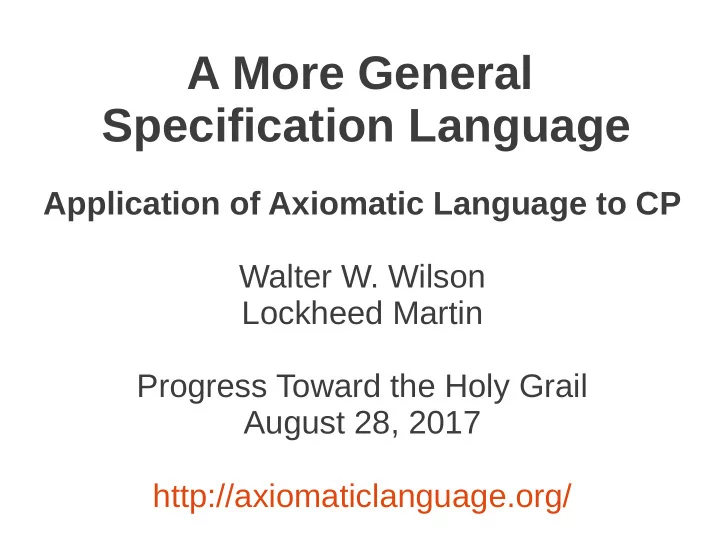

A More General Specification Language Application of Axiomatic Language to CP Walter W. Wilson Lockheed Martin Progress Toward the Holy Grail August 28, 2017 http://axiomaticlanguage.org/
Language Goals 1. pure specification – what, not how 2. minimal, but extensible 3. metalanguage – able to imitate other languages
Specification by Enumeration Idea : Program external behavior defined by infinite set of symbolic expressions that enumerate inputs and corresponding outputs. Program that reads input file and writes output file: (Program <input> <output> ) Enumeration of program to sort lines of a text file: (Program () ()) – empty input file … (Program ("dog" "pig" "cat") – 3-line input ("cat" "dog" "pig")) – sorted output …
Recipe ● minimal, pure, definite Prolog with Lisp syntax ● higher-order generalization [HiLog] ● string variables
The Core Language (1) Axioms generate valid expressions. expression : atom , – `abc , `+ expression variable , – %x , %1 sequence of >=0 expressions and string variables – (`M () $1 %)
The Core Language (1) Axioms generate valid expressions. expression : atom , – `abc , `+ expression variable , – %x , %1 sequence of >=0 expressions and string variables – (`M () $1 %) axiom : conclusion expr and >= 0 condition exprs <conclu> < <cond1> , …, <condn> . <conclu> . ! unconditional axiom
The Core Language (2) axiom instance : substitute values for variables (`A %x $1)< (`B %x), (`C $1). → (`A `x `u ())< (`B `x), (`C `u ()).
The Core Language (2) axiom instance : substitute values for variables (`A %x $1)< (`B %x), (`C $1). → (`A `x `u ())< (`B `x), (`C `u ()). valid expressions : If all conditions of an axiom instance are valid expressions, the conclusion is valid. (`a `b). ((%) $ $)< (% $). → (`a `b), ((`a) `b `b), (((`a)) `b `b `b `b), …
Syntax Extensions single char in single quotes: 'A' = (`char (`0 `1 `0 `0 `0 `0 `0 `1)) char string in single quotes within sequence: (… 'abc' …) = (… 'a' 'b' 'c' …) char string in double quotes: "abc" = ('abc') = ('a' 'b' 'c') symbol not starting with special char: abc = (` "abc")
Example – Natural Numbers Set of natural numbers: (num (`z)). (num (`s $))< (num ($)). → (num (`s `s `z)) Addition of natural numbers: (plus %n (`z) %n)< (num %n). (plus %1 (`s $2) (`s $3))< (plus %1 ($2) ($3)). → (plus (`s `z) (`s `z) (`s `s `z))
SEND + MORE = MONEY ! top-level axiom for generating solution as a valid expr (solution: $eqn)< (== ($eqn) (%S %E %N %D + %M %O %R %E = %M %O %N %E %Y)), (different- digit (%S %E %N %D %M %O %R %Y)), ! -- distinct 1-digit symbols (/= %S 0), (/= %M 0), (equation ($eqn)). ! equation must be satisfied ! -- grammar merges adjacent digits to form number → (solution: 9 5 6 7 + 1 0 8 5 = 1 0 6 5 2) See www.axiomaticlanguage.org/PTHG/SEND_MORE.txt for more details and …/PTHG/util/*.txt for utility predicates.
Sudoku Program Sudoku Puzzle input file: Input: _ 1 _ _ 8 _ _ _ _ _ 1 _ | _ 8 _ | _ _ _ 6 5 _ 7 _ _ 4 _ _ 6 5 _ | 7 _ _ | 4 _ _ _ _ _ _ 2 4 _ 9 _ _ _ _ | _ 2 4 | _ 9 _ _ 9 _ _ _ 7 6 _ _ ---------+---------+--------- … _ 9 _ | _ _ 7 | 6 _ _ … output file → Solution: See …/PTHG/Sudoku.txt 2 1 4 | 9 8 6 | 5 7 3 6 5 9 | 7 3 1 | 4 2 8 8 7 3 | 5 2 4 | 1 9 6 ---------+---------+--------- 4 9 8 | 2 1 7 | 6 3 5 …
Blend Program Find lowest cost blend of 2 feed ingredients with sufficient nutrients. ! x1,x2,xf,cost: - optimal relative ingredient kg quantities and cost (x1,x2,xf,cost: %x1 %x2 %xf %cost)< ! relative int ingredients & N-kg cost (== %N 100), ! total quantity being considered -> resolution of solution ! -- could choose higher-resolution solution here, say, parts per 1000 (iota_d %N %0-N), ! decimal numbers from 0..N (APL fn name) (cartesian %0-N %0-N %0-N %args), ! % ranges of the 3 ingredients ! -- This generalized cartesian product forms 3-element tuples ! of all combinations of integers from 0..N. (constraints ! -- arg vars _0, _1, _2 represent ingredients filler,1,2 ((_0 + _1 + _2 = %N) ! 3 natural number vars sum to N (100 * _1 + 200 * _2 >= 90 * %N) ! A nutrient grams required ( 80 * _1 + 150 * _2 >= 50 * %N) ! B ( 40 * _1 + 20 * _2 >= 20 * %N) ! C ( 10 * _1 >= 2 * %N) ! D ) ! each constraint formula must evaluate to true %args %selected_args), ! %selected args are tuples that satisfy cnstrs (minimize (40 * _1 + 60 * _2) %selected_args %cost (%xf %x1 %x2)). See …/PTHG/blend.txt
Conclusion ● Specifications – software engineering benefit – Smaller, more readable, more reusable, more correct – Good for CP ● Minimal & pure – well-suited to proof – Equivalence of specification and program – Prove assertions to validate specification ● Implementation grand challenge – Transformation of specifcations to programs – A harder Holy Grail
Recommend
More recommend